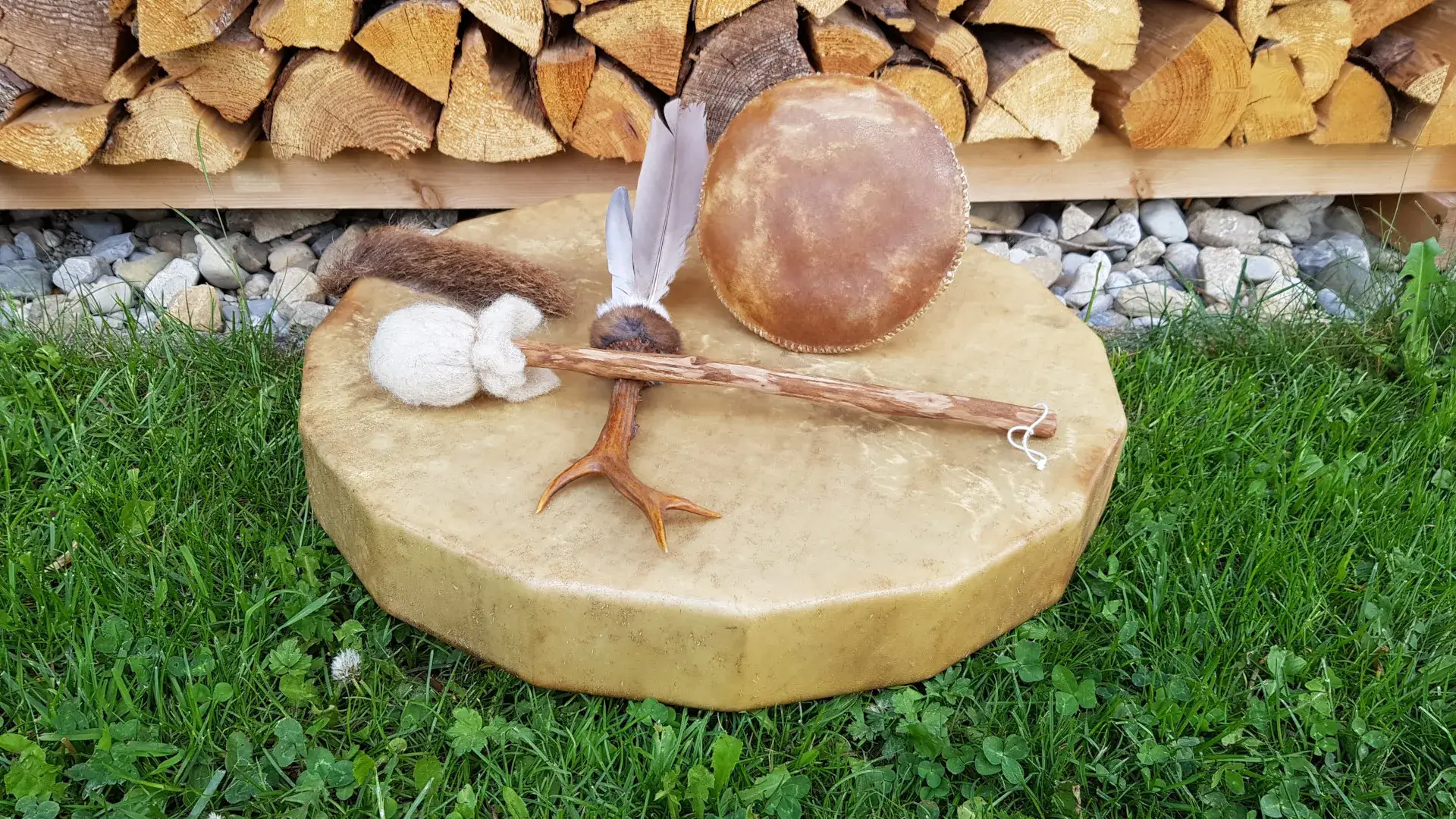
The drum of the shamans
Drum / shaman drum / frame drum
The drum is probably the best-known shamans tool. Hardly anyone who can relate to the term shaman doesn’t have a drum in the back of their mind.
And indeed, the drum is a very important companion of a shaman. She helps him to go into a trance and on a shamanic journey to the other world.
Although a drum is not absolutely necessary, a shaman can also connect with the spiritual world without any aids. But it helps him, creates a defined framework and also involves his clients in the work.
And depending on the cultural background, drumming is also expected of him, so that his work can only be accepted if he fulfills this expectation. Imagine a Catholic service where the priest leaves out half of it … the visitors would reject his work.
How such a drum should be constructed varies greatly from culture to culture. The more traditional the shaman is, the more he has to consider. Some shamanic cultures, for example, demand that they be made from a sacred tree in accordance with a variety of rituals that are passed down from generation to generation.
Whereas the modern European shaman is allowed to go much more by what he experiences directly from the spiritual world.
Because in this country we hardly have a continuous tradition that we have to strictly follow.
This explains the many different approaches to the shaman drum and shamanism in general.
Playing style
The shaman drum is usually struck with a drumstick, more rarely with the bare hand. And in a constant rhythm that creates a light trance over time.
This constant rhythm is at a frequency between 4 and 8 Hz. This frequency amplifies the theta waves that can be measured in the brain in this state.
These states have already been scientifically investigated several times, admittedly only in relation to measurable physical sensations and phenomena, but still.
The shaman can use his drum not only to put himself into a light trance, but also into complete ecstasy, depending on the culture in which he works and what is expected of him.
The shaman does not really “play” the drum, but rather surrenders to the drum and the Otherworld, or works together with the drum. The exact frequency of the drumming can never be determined beforehand and the rhythm, pitch and volume can vary during the drumming without the shaman consciously influencing this.
How do I get a shaman drum?
Opinions differ on this question and the answers can sometimes be extreme.
Some would love to go into the forest, cut down the tree for the wood, then kill a deer with their bare hands, strip it and work on the skin.
Then cut up the tree with axes, build a frame from the full wood and cover it naked, facing east, with the skin on a hollow path at midnight. Sing sacred songs and then only use the drum in sacred moments.
Others say: “just buy one from Amazon”.
The truth lies somewhere in between and has to be found out by everyone who wants a drum. Following your own instincts is certainly a good approach.
If you feel like it, you can build one yourself. There are various instructions online as well as seminars and courses. I myself regularly offer a drum building course, see: Drum building seminar
If you don’t feel like building one yourself, just buy one. Whether it’s a drum from a flea market or one built by a shaman is up to you. Here you can find the drums I have built and are for sale: Drums & Rattles
Frame drum
The drums used by shamans are usually frame drums, i.e. drums with flat frames that are covered on one side, or more rarely on both sides, with drum skin, i.e. an untanned animal skin.
In musical circles, the distinction between frame drum and cylinder drum is even defined in the so-called Hornbostel-Sachs system. This states that the height of the frame of a frame drum may not exceed the head radius. Everything above this results in a cylinder drum.
However, this does not really matter for the shaman, as the frame height of most shaman drums is well below this limit.
The frame does not necessarily have to be round, it can take on any shape that is technically feasible. The most common shape is probably the circle, closely followed by polygons with different numbers of corners.
Irregularly shaped frames are also known, for example those made from grown tree slices. Rare and therefore very exclusive are triangular frame drums that produce a very special sound
Frame drums are struck either with a mallet or by hand. The types of mallets vary greatly, from leather, felt and cork to combinations of these, everything is conceivable that produces a good sound.
Sometimes additional cymbals, bells, jingles or metal rings are attached to or in the frame, which resonate with the drums and make additional noises.
The frame drum is probably one of the oldest drum types of all, with depictions from Mesopotamia dating back to around 3000 B.C. These depictions show women holding frame drums strung on both sides in front of them. Perhaps they are also combinations of drum and rattle.
They are almost certainly not musical instruments but ritual objects.
But this type of drum probably made the rounds quite quickly and can be found as shaman drums in northern Europe, especially in Lapland and throughout Asia, mainly in Mongolia.
It is just as common in North and South America, frame drums are known among the Indians and the Spanish and Portuguese conquistadors brought them to South America.
They are also known in the Orient. Here, however, it is more of a musical instrument that is struck with the fingers. This design has also been known in Italy for a long time. It even appears in the Old Testament of the Christian Bible.
Types
The construction of a frame drum is very simple. A (usually) dehaired but not tanned animal skin is stretched over a frame, which is usually made of wood but can also be made of plastic or metal.
In the simplest case, the tension is created by drying the skin. If an untanned animal hide gets wet, it expands. If you stretch them wet over the frame and leave them to dry, the tension will be created automatically.
Most shaman drums are built in this way, as they do not require any major technical gimmicks, metal parts or even plastic.
The disadvantage is that these drums are sensitive to moisture. If the humidity is too high or if it gets wet, the tension drops and the drum sound becomes deeper, or it no longer sounds at all because the tension is gone.
Then it has to be dried again by placing it in the sun, keeping it in the living room at home or holding it by the fire. Shamans even appreciate these qualities, because a drum is not a “dead” object but a living being that is not always available at all times.
For musical purposes, frame drums are fitted with tuning screws with which the tension of the drum skin can be adjusted. This means they can be matched to other instruments. Tunable drums can of course also be used for shamanic purposes.
Recently, there have also been designs with inserted bicycle tubes that stretch the skin via pumped-in air pressure. Whether you want to work shamanically with a drum that has a rubber tube inside it is up to you.
Animal suffering
Another “trend” is plastic diaphragms, which have long been used in drums. These drums are often offered as “vegan” drums. The argument is then that you don’t want to have a drum for which an animal has died.
However, this is hardly a valid argument, as the goat, calf, deer, reindeer etc. skins used for shaman drums all come from animals that were slaughtered for food and certainly not to make a drum.
The skins are often downright “waste products” that are even thrown away.
In itself, everyone has to decide for themselves, shamanic journeying is also possible with a plastic drum.
